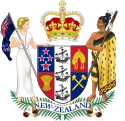Tauranga
| Tauranga Tauranga-moana (Māori) |
|
|---|---|
| — Metropolitan Area — | |
 Tauranga
|
|
| Coordinates: | |
| Country | |
| Region | Bay of Plenty |
| Territorial authority | Tauranga City |
| Settled | 1838 |
| Gazetted as a Borough | 1882 |
| City constituted | 17 April 1963 |
| Electorate(s) | Tauranga Bay of Plenty |
| Government | |
| - MP (Tauranga) | Simon Bridges (National) |
| - MP (Bay of Plenty) | Tony Ryall (National) |
| - Mayor | Stuart Crosby |
| Area | |
| - Territorial | 168 km2 (64.9 sq mi) |
| Highest elevation | 232 m (761 ft) |
| Lowest elevation | 0 m (0 ft) |
| Population (June 2010 estimate)[1] | |
| - Territorial | 114,300 |
| - Density | 680.4/km2 (1,762.1/sq mi) |
| - Urban | 120,000 |
| Time zone | NZST (UTC+12) |
| - Summer (DST) | NZDT (UTC+13) |
| Postcode(s) | 3110 - 3112 - 3113 - 3118 |
| Area code(s) | 07 |
| Website | http://www.tauranga.govt.nz/ |
Tauranga is the most populous city in the Bay of Plenty region, in the North Island of New Zealand. It was settled by Europeans in the early 19th century and was constituted as a city in 1963.[2] Tauranga City is the centre of the sixth largest urban area in New Zealand, with an urban population of 120,000 (June 2010 estimate).[1]
The city lies in the north-western corner of the Bay of Plenty, on the south-eastern edge of the Tauranga Harbour. The city expands over an area of 168 square kilometres (65 sq mi), and encompases the communities of (west to east) Bethlehem, Matua, Otumoetai, Greerton, central Tauranga, Maungatapu, Welcome Bay, Mount Maunganui, Bayfair and Papamoa .
Tauranga is one of New Zealand's main centers for business, international trade, culture, fashion, horticultural science, education and entertainment. It is home to renowned institutions covering a broad range of professional and cultural fields, and is one of the most substantial economic places, with the largest port in New Zealand, the Port of Tauranga.
Tauranga is one of New Zealand's fastest growing cities, with a 14 percent increase in population between the 2001 census and the 2006 census.[3]
Contents |
History
First settlers
The earliest known settlers arrived in Tauranga from the Takitimu and the Mataatua waka in the 12th century.[4].
Early trading
Traders in flax were active in the Bay of Plenty during the 1830s; some were transient, others married local women and settled permanently. The first permanent trader was James Farrow, who traveled to Tauranga in 1829, obtaining flax fibre for Australian merchants in exchange for muskets and gunpowder. Farrow acquired half an acre of land on 10 January 1838 at Otumoetai Pā from the chiefs Tupaea, Tangimoana and Te Omanu, the earliest authenticated land purchase in the Bay of Plenty.[5]
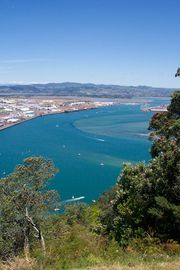
Missionaries
During the 1820s, missionaries from the Bay of Islands visited the Tauranga district to obtain supplies of potatoes, pigs and flax. In 1840, a Catholic mission station was established. Bishop Pompallier was given land within the palisades of Otumoetai Pā for a church and a presbytery. The mission station closed in 1863 due to land wars in the Waikato district.
New Zealand land wars
The Tauranga Campaign took place in and around Tauranga from 21 January to 21 June 1864, during the land wars. The Battle of Gate Pa is the best known.
Modern age
The population at the June 2010 estimate was 120,000,[1]: the city has tripled in size in a little over 25 years. The population increase is due mostly to retirees and to sun and surf seekers. It is also a popular lifestyle city. Although the population has increased dramatically, the city is proportionally underrepresented in businesses other than retail, which is over-saturated, and the CBD reflects a city of less than half its population. This is mainly because many outer suburb areas have shopping centres, including Fraser Cove, Fashion Island and Palm Beach Plaza, spreading retail dollars thin as property values and rents are very high.
Under the Local Government (Tauranga City Council) Order 2003,[6] Tauranga became legally a city for a second time, from 1 March 2004.
Geography
Tauranga is located around a large harbour that extends along the western Bay of Plenty, and is protected by Matakana Island and the extinct volcano of Mauao.
Situated along a faultline, Tauranga and the Bay of Plenty experience infrequent seismic activity, and there are a few volcanoes around the area (mainly dormant). The most notable of these are White Island and Mauao (Mount Maunganui), nicknamed "The Mount" by locals).
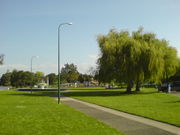
Climate
Due to its sheltered position on the east coast, Tauranga enjoys a warm, dry climate. This has made it a popular location for lifestyle. During the summer months the population swells as the holidaymakers descend on the city, especially along the popular white coastal surf beaches from Mount Maunganui to Papamoa.
| Climate data for Tauranga | |||||||||||||
|---|---|---|---|---|---|---|---|---|---|---|---|---|---|
| Month | Jan | Feb | Mar | Apr | May | Jun | Jul | Aug | Sep | Oct | Nov | Dec | Year |
| Source: NIWA Climate Data[7] | |||||||||||||
Population
In New Zealand, Tauranga is the sixth largest city by urban area, overtaking Dunedin in 2008, and ninth largest city by Territorial Authority area. The city was growing at a rate of 1.5% in 2008.
In 1976, Tauranga was a medium-sized urban area, with a population of around 48,000, smaller than Napier or Invercargill. The completion of a harbour bridge in 1988 brought Tauranga and ‘the Mount’ closer (they amalgamated in 1989) and has promoted growth in both parts of the enlarged city. In 1996 Tauranga’s population was 82,092 and by 2006 it had reached 103,635.
In 2006, 17.4% of the population was aged 65 or over, compared to 12.3% nationally, but there are many in their teens and twenties. The city hosts five major head offices – Port of Tauranga, Zespri International, Ballance Agri-Nutrients Ltd, Trustpower and Craigs Investment Partners (formerly, ABN AMRO Craigs).
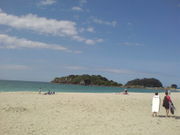
Housing
In recent years there has been a housing 'boom' which meant the huge increase of houses being built within Tauranga, especially in the largest suburb, Papamoa. Papamoa's huge growth has been due greatly to this boom and therefore made it the largest suburb in Tauranga. Some suburban areas within Papamoa that have been built up include The Gardens, Emerald Shores, Golden Sands, Palm Springs, and Tuihana. Although the Housing boom is officially over in Tauranga, construction is still occurring and suburbs are being built. These are Coast Papamoa, Papamoa Junction and Modena Beach The main housing in Tauranga varies between suburbs, and range from wealthy beachfront mansions to older state houses in the lower income neighbourhoods. The most common type of housing is suburban houses with medium sized backyards. Many people live across from the beach. Tauranga is generally expensive when it comes to housing. In 2008 the median sale price for houses was around $400,000, varying from around $200,000 to a around $3 million.
Economy
Local industry
Much of the countryside surrounding Tauranga is horticultural land, used to grow a wide range of fresh produce for both domestic consumption and export. The area is particularly well known for growing tangelos (a grapefruit / tangerine cross), avocados, and kiwifruit. Recent years have seen the establishment of boutique vineyards and wineries.
The Port of Tauranga is New Zealand's largest export port, with brisk but seasonal shipping traffic. It is a regular stop for both container ships and luxury cruise liners.
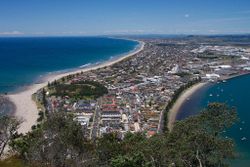
Shopping
Shopping malls include Bayfair Shopping Centre and Palm Beach Plaza. Most of the city's shopping is suburban and located around the suburbs. Places include Fraser Cove Shopping, Bethlehem Shopping Centre, Fashion Island, Downtown the Mount, Brookfield and Greerton Village. In 2008 Tauranga CBD underwent renovations to attract more shoppers to the inner city.
Arts and Culture
Religion
Because of Tauranga's large multi-ethnic population, a wide variety of faiths are practiced, including Islam, Buddhism, Hinduism, various Eastern Orthodox Churches, Sufism and others. Immigrants from Asia have formed a number of significant Buddhist congregations.
The main faith present throughout Tauranga and most of the country is Christianity. There are many types of Christians, including: the largest, Pentecostal, Catholic, Methodist, and Presbyterian. With Jews in the metropolitan area, the region also has a good amount of Jews within New Zealand. There are also Roman Catholic Churches with numerous Catholic churches and parishes throughout the city. The Church of Jesus Christ of Latter-day Saints is in Bethlehem, west Tauranga. The grounds includes a visitors' centre and the headquarters of the Tauranga Mission.
Attractions
Greater Tauranga is a very popular lifestyle and tourism destination. It features many natural attractions and scenery. Cultural attractions include the Tauranga Art Gallery, which opened in October 2007 and showcases local, national and international exhibitions in a range of media.
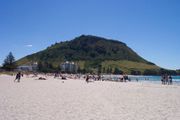
Events
The National Jazz Festival is one of the many that take place in Tauranga every Easter, with dozens of live acts, great food and excellent wine.
New Year celebrations at the Mount in Mount Maunganui are one of Tauranga's main events, bringing people from all around the country.
Lifestyle
The coastal suburb Papamoa and neighbouring town Mount Maunganui are some of the more affluent areas around Tauranga. The region’s beaches attract swimmers, surfers, kayakers and kitesurfers throughout the year.
Tauranga has many outlying islands and reefs that make it a notable tourist destination point for traveling scuba divers and marine enthusiasts. Extensive marine life diversity is available to scuba divers all year round. Water temperatures range from 12 degrees celsius in winter to 22-24 degrees celsius in summer. Tauranga houses two professional dive instructor training centers, training NAUI, PADI, and SSI dive leader systems.
Accommodation options such as hotels, motels, holiday parks and lodges make the most of the coastal views.
Sports
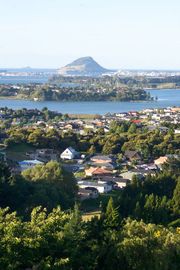
Tauranga has a large stadium complex in the Bayfair suburb, Baypark Stadium, rebuilt in 2001 after a similar complex closed in 1995. It hosts Speedway events during summer and rugby matches in winter.
Parks and recreation
Tauranga has many parks. One of the largest is Memorial Park, and others include, Yatton Park, Kulim Park, Fergusson Park and the large Tauranga Domain.
Due to the temperate climate, outdoor activities are very popular, including golf, tramping (hiking), mountain biking and white water rafting. The Bay of Plenty coastline has miles of golden sandy beaches, and watersports are very popular, including swimming, surfing, fishing, diving, kayaking and kitesurfing. Tourists also enjoy dolphin-watching on specially run boat trips.
Education
Tauranga is home to the Bay of Plenty Polytechnic and a branch of the University of Waikato.
The main state secondary schools include:
- Aquinas College a co-educational state-integrated Catholic school founded in 2003 for years 7 through 13.
- Tauranga Boys' College, with over 1800 boys.
- Tauranga Girls' College, with over 1500 girls.
- Otumoetai College, with around 1900 pupils.
- Bethlehem College, a Christian educational institution for kindergarten, primary and secondary level students, with around 1500 students.
- Mount Maunganui College, a co-educational secondary school, with over 1500 students.
Christian educational institutions in Tauranga include Bethlehem Campus, a college for both children and adults established in 1988; Tauranga Adventist School, a state integrated Christian community school catering for Year 1 to 8 students and established in 1974; and Aquinas College, a Catholic college established in 2003.
There is also a Rudolf Steiner School in Welcome Bay, catering for birth to 12 year olds.
Infrastructure
Transportation
One of the main transportation methods in the city are the Bay Hopper bus and Go Bus.
Tauranga Airport provides daily domestic flights to all around the country.
Notable residents
- Hilda Hewlett - pioneer aviator
- Phil Rudd - drummer for AC/DC
- Richard O'Brien - author of The Rocky Horror Show (spent his formative years here)
- Les Munro - Dambusters veteran.
- Bob Clarkson - former Member of Parliament and successful property developer and landlord
- Mahé Drysdale - Olympic rower
- Andrew (Herb) Stevenson - Olympic rower, Double World Champion Rower, NZ 1982 Sportsman of the Year
- Tim Balme - actor, director
- Winston Peters - former MP for Tauranga, leader of NZ First, politician
- Moss Burmester - Olympic swimmer
- Simon Bridges - politician
- Aaron De Mey - makeup artist, Artistic Director, Lancome (spent formative years here)
- John Bracewell - International Cricketer
- Dame Susan Devoy - former World Squash Champion
- Tony Lochhead - footballer
Past residents
Sister cities
See also
- Port of Tauranga
- Tauranga Airport
- Tauranga Cup
- Tauranga Harbour
References
- ↑ 1.0 1.1 1.2 "Subnational population estimates at 30 June 2010 (boundaries at 1 November 2010)". Statistics New Zealand. 26 October 2010. http://www.stats.govt.nz/~/media/Statistics/Methods%20and%20Services/Tables/Subnational%20population%20estimates/subnational-pop-estimate-jun2001-2010.ashx. Retrieved 26 October 2010.
- ↑ "Local Government 1860 - present". Tauranga City Council. http://www.library.tauranga.govt.nz/localhistory/european-settlement/the-rule-of-law.aspx. Retrieved 2008-12-19.
- ↑ Quickstats about Tauranga City
- ↑ VTours - Downtown Tauranga
- ↑ http://www.tauranga.govt.nz/knowledgebase/tabid/624/qid/1164/tctl/1332_ViewQuestion/Default.aspx
- ↑ http://www.knowledge-basket.co.nz/regs/regs/text/2003/2003275.txt
- ↑ "Climate Data". NIWA. http://www.niwascience.co.nz/edu/resources/climate/. Retrieved November 2, 2007.
- ↑ "Kiwi leads Idol show by a neck". The Dominion Post. 10 September 2009. http://www.stuff.co.nz/entertainment/2849353/Kiwi-leads-Idol-show-by-a-neck/. Retrieved 2009-11-03.
- ↑ Sister cities
External links
- Tauranga City Council
- Tauranga City Libraries
- Tauranga Portal Website
- Local History portal — Tauranga City Libraries
|
|||||||||||||||||||
|
||||||||||||||||||||||||||||||||
